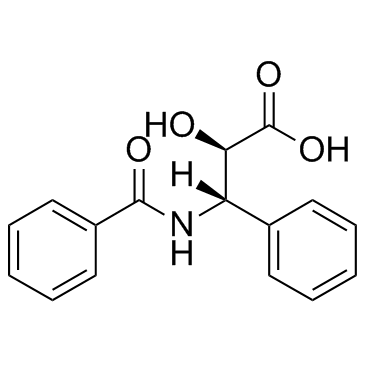
N-Benzoyl-(2R,3S)-3-phenylisoserine
CAS No. 132201-33-3
N-Benzoyl-(2R,3S)-3-phenylisoserine( —— )
Catalog No. M17948 CAS No. 132201-33-3
(2R, 3S)-N-Benzoyl-3-phenylisoserine is an intermediate in the preparation of potent anticancer drug Paclitaxel used to study the location of the binding sites.
Purity : >98% (HPLC)
 COA
COA
 Datasheet
Datasheet
 HNMR
HNMR
 HPLC
HPLC
 MSDS
MSDS
 Handing Instructions
Handing Instructions
| Size | Price / USD | Stock | Quantity |
| 10MG | 35 | In Stock |


|
| 25MG | 56 | In Stock |


|
| 50MG | 82 | In Stock |


|
| 100MG | 120 | In Stock |


|
| 200MG | Get Quote | In Stock |


|
| 500MG | Get Quote | In Stock |


|
| 1G | Get Quote | In Stock |


|
Biological Information
-
Product NameN-Benzoyl-(2R,3S)-3-phenylisoserine
-
NoteResearch use only, not for human use.
-
Brief Description(2R, 3S)-N-Benzoyl-3-phenylisoserine is an intermediate in the preparation of potent anticancer drug Paclitaxel used to study the location of the binding sites.
-
Description(2R, 3S)-N-Benzoyl-3-phenylisoserine is an intermediate in the preparation of potent anticancer drug Paclitaxel used to study the location of the binding sites. It shows cytotoxic, antiviral and immunomodulatory activity.
-
In Vitro——
-
In Vivo——
-
Synonyms——
-
PathwayOthers
-
TargetOther Targets
-
RecptorOthers
-
Research Area——
-
Indication——
Chemical Information
-
CAS Number132201-33-3
-
Formula Weight285.29
-
Molecular FormulaC16H15NO4
-
Purity>98% (HPLC)
-
SolubilityIn Vitro:?DMSO : ≥ 160 mg/mL (560.83 mM)
-
SMILESO[C@H]([C@@H](NC(=O)c1ccccc1)c1ccccc1)C(O)=O
-
Chemical Name——
Shipping & Storage Information
-
Storage(-20℃)
-
ShippingWith Ice Pack
-
Stability≥ 2 years
Reference
1. Paal K, et al. Paclitaxel binding to human serum albumin--automated docking studies[J]. Bioorganic & Medicinal Chemistry, 2007, 15(3):1323-1329.
molnova catalog



related products
-
Nuclomedone
Nuclomedone is a biochemicals.
-
Peonidin-3,5-O-diglu...
Peonidin-3,5-O-diglucoside chloride is a natural product.
-
PF-4840154
PF-4840154 is a potent, selective agonist of the rat and human TrpA1 channel and elicited TrpA1-mediated nocifensive behaviour in mouse, with EC50 of 97 nM and 23 nM for rTrpA1 and hTrpA1, respectively.



 Cart
Cart
 sales@molnova.com
sales@molnova.com


